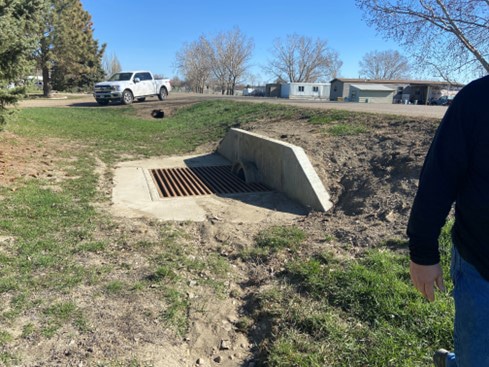
City of Sidney Stormwater Master Plan
Delivering a Clear, Multi-Faceted Plan for Stormwater Management
Historically, the City of Sidney has managed stormwater without a dedicated utility, which means no formal structure for funding, staffing, and maintaining stormwater infrastructure. It became clear that the city needed a more organized, proactive approach as the community grew and experienced increasingly frequent and intense storm events.
After recognizing the growing risks of urban development, aging infrastructure, and more frequent heavy rainfall events, the city took a proactive step: developing its first-ever Storm Water Master Plan.
This plan assessed existing stormwater infrastructure, identified critical problem areas, and laid the groundwork for stormwater management. The plan provides a clear roadmap for stormwater management, staffing, equipment needs, and long-term funding strategies.
Morrison-Maierle led the effort to deliver a clear, data-driven roadmap for Sidney’s future. The plan outlines how the city can systematically fund, manage, and improve its stormwater infrastructure over the next decade. Through this process, Sidney has the tools to shift from reactive fixes to long-term, sustainable stormwater management.
Services and Highlights
-
Capital improvements planning
-
Funding strategy
-
Master planning
-
Rate recommendations
-
Identified existing background
-
Provided a stormwater system analysis
-
Provided management recommendations


Inside the Plan
The City of Sidney Storm Water Master Plan creates a guide for improving stormwater infrastructure, managing flood risks, and planning capital improvements.
The plan tackles a few key objectives, including:
- Providing a comprehensive look at the current system.
- Identifying problem areas.
- Outlining potential stormwater management strategies.
- Prioritizing capital improvement projects to be implemented over a ten-year period.
The report is organized into four major sections, each building on the last to create a complete picture of the city’s stormwater needs and solutions.
The Four Sections
Section 1 - Existing System Background
The first section focuses on gathering and analyzing all available background information about the city’s stormwater infrastructure. Initially, the city had no central record of the infrastructure in place. To address this and to reduce the cost of professional field surveying, we worked closely with city staff to help set up a GIS-based inventory data collection process.
The collected information—including the locations, sizes, and conditions of outfalls, utility holes, inlets, and culverts—was compiled into a centralized GIS database, providing a critical foundation for mapping the system, identifying problem areas, and supporting long-term planning and maintenance.
In addition to inventory work, this chapter compiles supporting information such as existing ordinances, FEMA floodplain maps, rainfall and soil data, and records of past flooding or system deficiencies. It also establishes the hydrologic basins that shape how runoff moves through Sidney, highlighting areas with persistent issues like undersized pipes, eroded ditches, and poor drainage.
Section 2 - Stormwater System Analysis
Section two focuses on the hydrologic and hydraulic modeling of the existing stormwater system. Hydraulic models were developed to simulate 10-year and 100-year rainfall events across key drainage basins. The modeling highlighted areas vulnerable to flooding and the conceptual designs of proposed improvements. These included upgraded pipes, new inlets, detention basins, and channel enhancements to reduce property damage and improve system function during heavy storms.
Section 3 - Stormwater Utility Management Recommendations
The third section outlines the path forward for when Sidney elects to formalize their stormwater utility. It provides recommendations for utility staffing, equipment needs, and maintenance operations. The plan recommends leveraging shared administrative and field staff, purchasing essential equipment, and implementing a regular maintenance schedule to ensure system reliability. This section also reviews the city’s existing codes and policies, identifying potential updates to better support long-term stormwater management.
Section 4 - Capital Improvements Plan (CIP)
The final section presents a ten-year Capital Improvements Plan that prioritizes stormwater projects based on criteria like public safety, regulatory compliance, and cost-effectiveness. CIP projects were developed for locations with documented flooding, undersized or deteriorated infrastructure, or no formal drainage system at all. These issues were initially flagged through background research, past reports, and city staff input. To support implementation, the plan also includes cost estimates and concept-level designs for each project.
Importantly, the CIP includes guidance on potential funding sources to help the city plan for long-term investments. These include options such as federal and state grants, low-interest loan programs, and eventual revenues from a future stormwater utility. By identifying both funding needs and opportunities, this chapter equips Sidney with a clear financial path to implement the recommended improvements in a phased and strategic way.
Setting a Foundation for Progress
Together, these four sections provide the City of Sidney with a clear and actionable framework for improving its stormwater infrastructure. The plan balances technical precision with practical recommendations, empowering the city to move from reactive stormwater management to a proactive, resilient approach.
Learn more about our stormwater capabilities.Related Projects

Caras Park Stormwater Treatment and Park Improvements
The Caras Park Stormwater Treatment and Park Improvements project combined two projects into one to help the City of Missoula reduce closure time and save construction costs.

Meadows Stormwater Flood Mitigation
The Meadows Stormwater Flood Mitigation project addressed complications resulting from years of severe flooding events in Sidney, MT.

Billings Airport Storm Drainage System
Billings-Logan International Airport needed a solution to control the large stormwater events on the airfield, put the water in a new pond structure, and drain them to a creek.